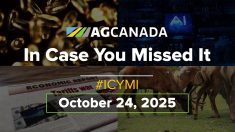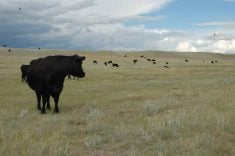ALTONA, Man. – Manitoba hog farmers are seeing red over a 20-cent levy on weanlings leaving the province.
The Manitoba Pork Council, which imposed the levy, has met several times with producers and will work to resolve concerns, said chair Marcel Hacault.
The first levies were collected at the end of August.
The pork council determined in 1997 that weanling producers benefit about 20 cents a pig from the universal $1 levy per market animal. As a result, it reduced the market hog levy to 85 cents and tacked a 20-cent levy onto the exported weanlings.
Read Also

Volatile temperatures expected for this winter
DTN is forecasting a lot of temperature variability in the Canadian Prairies this winter. Precipitation should be close to average.
Manitoba producers, who exported 800,000 weanlings in 1998, weren’t impressed.
Verna Heinrichs and husband Andrew ship about 30,000 weanlings annually from their Buffalo Creek Farms near Altona, Man.
“At best, the timing couldn’t be worse,” said Heinrichs, the farm’s chief executive officer.
“It’s an audacious move on the part of the Manitoba Pork Council, especially at this time.”
She called the levy overkill because producers selling weanlings across the Canada-United States border already face considerable red tape and fees.
“We’re already paying fees that cover the same thing.”
Heinrichs said Manitoba needs a weanling exporters association with representation according to numbers of weanlings shipped out of the province.
“We need a say in what happens.”
Larry Friesen of Hanger Farmers near Rivers, Man., said each jurisdiction to which pigs are shipped charges a fee to help promote pork and serve the industry.
“It’s a duplication of levies.”
He also questioned the pork council’s decision to impose the same levy on all weanlings, especially since it reduced the levy on a market pig from $1 to 85 cents.
“If they’re going to do that, then there should be separate categories for feeder pigs, butcher hogs, weanlings … or piglets,” he said.
“There’s a clear distinction between the value of those different animals.”
Friesen agreed a separate organization is needed to represent weanling producers and exporters.
“At the very least we should have a seat at the MPC.”
Hacault is happy that some of the major producers are getting involved.
He met recently with exporters and said there is progress.
The biggest issue is the lack of weanling exporter representation on the pork council. Hacault said weanling producers could either nominate their own representative or take advantage of open positions that exist in the council’s delegate structure.
He admitted one fee for all weights is a concern, but said the council wants to concentrate first on making the system work.
“We acknowledge that 20 cents on a $15 hog is a higher percentage than 20 cents on an $80 hog.”
Hacault said the council needs the weanling exporters to help find a solution.














